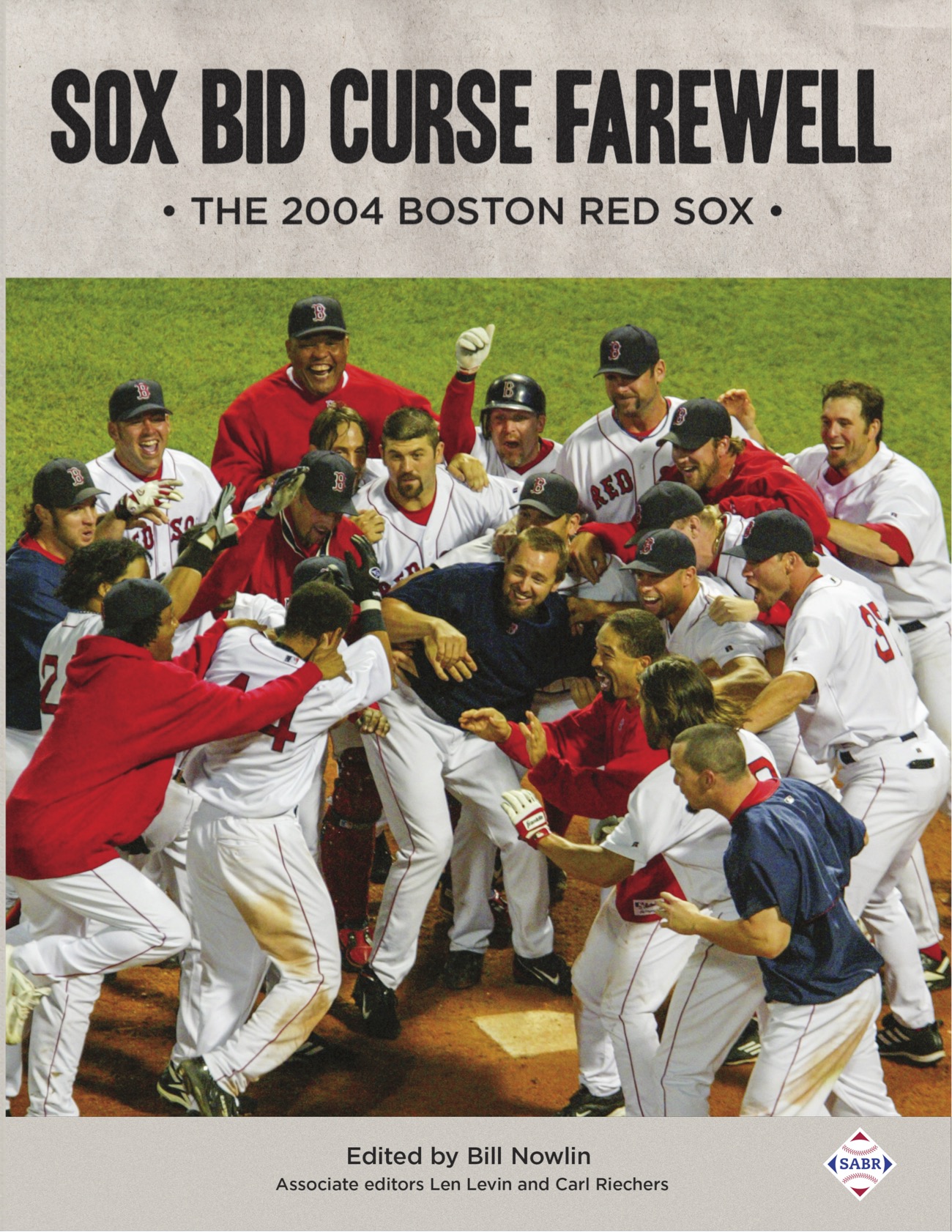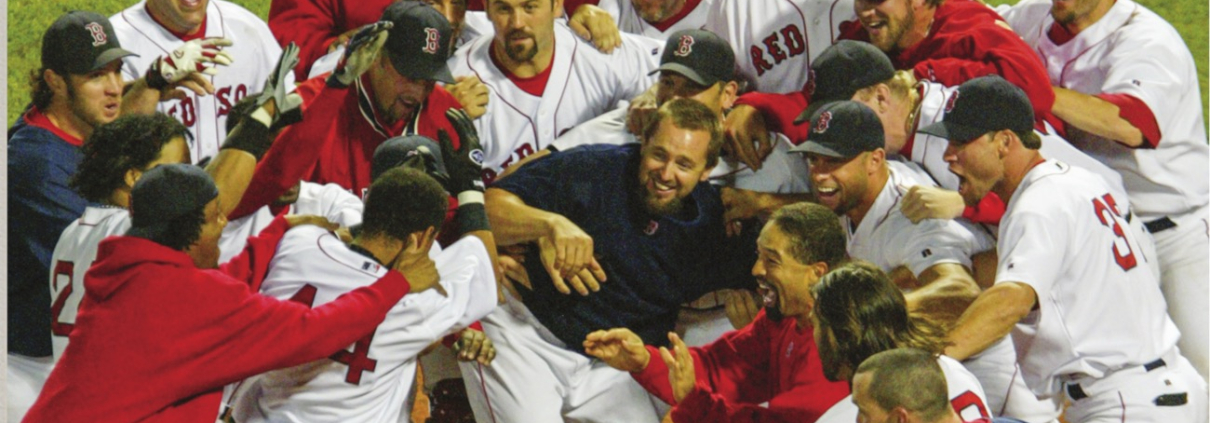2004 Red Sox: Curse Reversed
This article was written by Joanne Hulbert
This article was published in Sox Bid Curse Farewell: The 2004 Boston Red Sox
 Eighty-six years. Decades of near-misses and long-shot losses that kept a World Series win out of reach of the Boston Red Sox. Years turned into decades and – occasionally – a near-miss tantalized the team and fans. What could possibly have been the reason for all the misfortune? Waiting until next year became an old, tired phrase that kept the Old Town Team looking forward but also sometimes glancing back, looking for reasons why this disappointing record kept on growing. Was it Frazee? Was it the Yankees? Inept managing? Or were the fans not rooting loud enough? Blame must be placed somewhere, or on someone. After all the excuses and theories faded away, all eyes turned toward Babe Ruth and the Curse of the Bambino. How, when, and why did the Boston Red Sox end up with this ethereal, poetic, and commercially lucrative explanation?
Eighty-six years. Decades of near-misses and long-shot losses that kept a World Series win out of reach of the Boston Red Sox. Years turned into decades and – occasionally – a near-miss tantalized the team and fans. What could possibly have been the reason for all the misfortune? Waiting until next year became an old, tired phrase that kept the Old Town Team looking forward but also sometimes glancing back, looking for reasons why this disappointing record kept on growing. Was it Frazee? Was it the Yankees? Inept managing? Or were the fans not rooting loud enough? Blame must be placed somewhere, or on someone. After all the excuses and theories faded away, all eyes turned toward Babe Ruth and the Curse of the Bambino. How, when, and why did the Boston Red Sox end up with this ethereal, poetic, and commercially lucrative explanation?
On January 5, 1920, a day of infamy for Boston’s baseball fans, Babe Ruth signed with the New York Yankees for the money and then some (two years at $10,000 per year with bonuses of $10,000 a year and $5,000 for signing), and he wanted $20,000 from Harry Frazee for signing a contract with Miller Huggins which was to come from the Boston club.1 That is what we know about the history that would ultimately set into motion the seeds planted for a curse upon the Boston Red Sox. Seventy years would pass by before the curse was revealed as the cause of Boston’s baseballic misfortune. All the usual suspects, Harry Frazee, Jacob Ruppert – and even the Bambino, Babe Ruth himself – none would live long enough to see how 86 years of Red Sox World Series drought would end.
In the days following the 1920 announcement, Boston newspapers did their best to defuse anxiety over Babe Ruth’s exit from Boston. Arthur Duffey wrote: “Why all this hubbub over the sale of Babe Ruth to the New York Yankees? Is the price worth the candle? Boston baseball fans are a pretty sensible lot and why wouldn’t it be a good idea to reserve judgment over the Ruth sale for a while until things really have had time to shape themselves? This is not the first time that Boston fans have been thrown a bit into the air with the sale of one of their star players, but in any of the former cases, did it work to the disadvantage of the Boston Club? Of course, it is going to be tough to see the champion fence buster disport in another uniform next season, but after the first storm of criticism has blown away I wouldn’t be surprised that if the sale of Ruth to the New York Yankees would prove one of the best things that could happen [to] the Boston Red Sox.”2
History tells a different tale about Babe Ruth and his celebrated baseball career in New York. When the Babe returned to Fenway Park in the 1920 season, the headline proclaimed: “Babe Ruth Is Here to Make Boston’s Holiday Complete.” Burt Whitman wrote, “He came into his own as a Red Sox and Hub fans always will keep their enthusiasm for him and his long-distance smashes.”3 No hard feelings, just “welcome back.”
As time went on, seasons came and went along with new hope that “this is the year!” The Red Sox counted up near-misses, miscalculations, optimistic predictions, and lost opportunities, and not even the greatest hitter who ever lived could singlehandedly rescue the entire franchise. The misfortune of the Red Sox inspired writers to compare the team in terms reminiscent of a Greek tragedy. In the Saturday Evening Post in 1946, Boston Globe writer Harold Kaese asked a simple question that was year after year repeated: “What’s the Matter with the Red Sox?”4
In 1986, as Boston went down to defeat in the seventh game of the World Series at the hands of the New York Mets, New York Times writer George Vecsey blamed the Bambino in his column titled “Babe Ruth Curse Strikes Again.” He wrote: “All the ghosts and demons and curses of the past 68 years continued to haunt the Boston Red Sox last night.”5
In 1990 the cause of decades of Red Sox misfortune was settled. Simply stated, the sale of Babe Ruth to the Yankees was the punishment endured by Boston for that colossal, disastrous decision. The person who unveiled the news was Dan Shaughnessy of the Boston Globe, who said he was informed of this curse by a woman whose grandfather had proclaimed, “Boston will not win a World Series because Babe Ruth was sold to the Yankees. It’s the Curse of the Bambino.”6
Despite all their efforts, must the Boston Red Sox endure some sort of punishment for a ruthless mistake made in 1920? Red Sox fans immediately embraced The Curse that explained away decades of misfortune. Newspapers devoted lines, paragraphs, stories, and The Curse was celebrated in books, including children’s literature.7
With new ownership and management changes, the 2003 season instilled hope that the Red Sox’ fortunes might improve. The gut-wrenching loss to the Yankees in that year’s ALCS only confirmed the awful suspicion that the Red Sox were indeed cursed, and something must be done about it.
In 2004, as the Red Sox advanced up the American League East standings, whispers rose to shouts that this might be the year that The Curse would be broken. There were visitations to the Bambino’s gravesite where curse-breaking offerings were left. Signs appeared around New England – “Reverse the Curse!” – and as if fans could sing a curse away, songs rang out in Fenway Park – “Dirty Water” – and a twenty-first-century version of an old tune, “Tessie,” by the Dropkick Murphys debuted in June 2004. The original song had been adapted and sung by the Royal Rooters at the first World Series back in 1903 and some of the losing Pittsburgh Pirates said it had rattled them, perhaps causing them to lose the World Series.
Had the Boston Red Sox won the World Series in 2004 because they vanquished The Curse of the Bambino? Or did the Babe finally let it go, giving a tip of his hat to Boston after the thrilling ALCS series against New York? There is another possibility. After Boston’s victory in the 1918 World Series, there appeared a curious headline and story about the end of the final game: “Tessie! Where was the Old ‘Gal’ at Fenway?” wrote H.W. Lanigan in the Boston American. “Where was ‘Tessie?’ Forsooth, there wasn’t any music at all. President Frazee planned to have music, but so great was the demand for grandstand seats that he was forced to sell the space he had allotted for the band. Curses!”8
Ed Martin, baseball writer for the Boston Globe, wrote, “The crowd did not come up to expectations. While there was no material evidence of the presence of ‘Tessie,’ she must have been there in spirit. It is the first time that any Boston club has been in a series that “Tessie” has not been heard from good and proper.”9 Tragically, Martin died of influenza less than a month after writing the lament.
The Dropkick Murphys, the Celtic punk band from Quincy, Massachusetts, played the new-and-improved “Tessie” live at Fenway Park on July 24, 2004. That also happened to be the same day Red Sox catcher Jason Varitek and New York Yankees star Alex Rodriguez conducted a mitt-a-mano brawl. It was the same game where Bill Mueller hit a game-winning walk-off home run to spoil Mariano Rivera’s perfect save streak, as well. The ghost of Babe Ruth must have been impressed.
“To this day, the Red Sox have never won a World Series without ‘Tessie,’” said Dr. Charles Steinberg, once a Fenway Park man-of-all-jobs. “The Red Sox had it in their first five world championships from 1903 to 1918, and we brought it back in 2004. It’s been part of Fenway Park’s musical culture.”10
Was the curse about the Babe? Or had the curse been about Tessie all along? “Tessie” disappeared after 1918 and reappeared in 2004. In 2016 the Tessie mascot joined Wally, and they roam Fenway Park at game time, amusing the fans and perhaps serving another purpose. “Hell hath no fury like a woman scorned,” wrote William Congreve in The Mourning Bride, published in 1697. To be on the safe side, “Tessie” continues being seen at Fenway Park, just in case, and is heard throughout the park after every Red Sox win.
JOANNE HULBERT is a Boston Chapter member and SABR Baseball and the Arts Committee co-chair, who knows well that although baseball is designed to break your heart, there are moments of great joy that remind us all that waiting for next year will be worth it.
Notes
1 “Babe Ruth to Get $45,000.” Boston Post, January 7, 1920: 1.
2 Arthur Duffey, “Sports Comment.” Boston Post, January 7, 1920: 11.
3 Burt Whitman, “Babe Ruth Is Here to Make Boston’s Holiday Complete.” Boston Herald, April 19, 1920: 7.
4 Dan Shaughnessy, At Fenway (New York: Crown. 1996), 94. Al Hirshberg wrote a book by that title: What’s the Matter with the Red Sox? (New York: Dodd, Mead and Company, 1973).
5 George Vecsey, “Babe Ruth Curse Strikes Again.” New York Times, October 28, 1986.
6 Shaughnessy, 94.
7 For instance, see Dan Shaughnessy and C.F. Payne, The Legend of the Curse of the Bambino (New York: Simon & Schuster/Paula Wiseman Books, 2005).
8 Ty Waterman and Mel Springer, The Year the Red Sox Won the World Series (Boston: Northeastern University Press, 1999), 244.
9 Edward F. Martin, “Wonderful Support When Babe Wobbles.” Boston Globe, September 10, 1918: 6.
10 “‘Tessie’ and the Dropkick Murphys, a Red Sox History,” www.oursportscentral.com, December 21, 2022. https://www.oursportscentral.com/services/releases/tessie-and-the-dropkick-murphys-a-red-sox-history/n-5908671.


